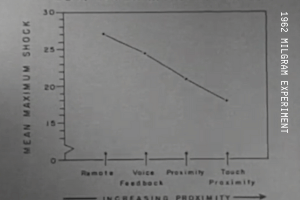The Milgram Experiment demonstrated that 66% of people in the study kept going in administering electric shocks to a stranger, to a deadly level and dispite verbal protests as long as the ‘researcher’ kept telling them to. The Milgram Experiment is now a famous psychological experiment. It was designed to answer the question how obedient people are in relation to an authority figure. This came in response to the fact that many German war criminals who were charged over WW2 events during the Nuremberg trials, had defended themselves with the ‘befehl ist befehl‘ excuse (that they were just following orders).
Who designed the Milgam Experiment?
Psychologist Stanley Milgram of Yale University conducted the experiment in social psychology. There were different situations that were tested and in each situation 40 men were tested. Men from all walks of life and success levels and standing in the community, who were attracted by newspaper advertisement and direct mail.
What test situations were tested in the Milgram Experiment?
The main concept of all testing in the Milgram Experiment was to see the level of obedience to an authority figure who kept telling them to conduct acts that went against their conscience and better judgement. All test involved the test subject ‘the teacher‘ to administer electric shocks to the ‘learner‘ (who as an actor and didn’t really get shocked). These shocks came in response to answering memory questions incorrectly and increased in voltage with each wrong answer. Beyond this, there were a few seperate variables that they wanted to test.
Variables tested in the Milgram Experiments were related to changing the distance that the ‘learner’ was removed from the ‘teacher’ and how this effected their willingness to obey. Secondly, the distance that the researcher was from the ‘teacher’ was tested. More specifically:

- In the first experiment, the learner was in a seperate room from the teacher and could not be heard. At the ‘300 Volt’ level, he would pound on the wall in protest and wasn’t heard from again (at higher shock levels)
- In the second experiment, the learner could be heard through the wall. This situation is shown in the film recording of the Milgram Experiment.
- In a third experiment, the teacher and the learner were only 1 and a half feet away from each other (50cm) and so the teacher could hear and see the ‘victim’.
- In the fourth condition, the teacher and the learner were at the same distance from each other but what was different was that the learner would only receive the shocks if they left their hand on a shock plate. Once the learner started refusing beyond the 150 volt level, the teacher was asked to hold down the learner’s hand on the shock plate and so physical involvement was now also part of the situation.
The more the test subject was closer to the victim, the less obedient they would be.

Another variable that was tested was the distance the researcher was away from the test subject. They tested this by another series of experiments that varied the physical closeness of the researcher and the level of involvement, by:
- In one condition the researcher sat just a few feet away from the test subject.
- In another condition, the researcher would be in the room to give instructions and then would leave the room and give further instructions by telephone.
- In a third condition, the researcher was never seen. Instead instructions were given on a tape recorder that was activated when the test subject entered the room.
The obedience dropped significantly when the researcher was ‘further away’. Obedience was nearly 3x as much when the researcher remained in the room when compared to giving instructions over the telephone.
It was considered that the location at Yale University might have had some level of impact on the obedience of the test subjects, as test subjects respected the Yale University greatly. This variable was also tested by conducting experiments in a somewhat rundown office building in industrial Bridgeport. Whilst obedience levels were a little less, the reduction was surprisingly little.
Results of the Milgram Experiment
The Milgram Experiment found that a high percentage of people would fully obey the instructions, with most going up to 300 Volt and 65% going up to the maximum 450 Volts.
Milgram first explained his research in the Journal of Abnormal and Social Psychology, in 1963. In 1974 he put his findings in his book ‘Obedience to Authority: An Experimental View’ in greater detail.

Influence Principle of Authority and the milgram experiment
Within Ethical Influence teaching, the Principle of Authority has always come with warnings. Of course we want to use the Principle of Authority ethically, but when we are the authority, we need to be aware that people may follow us without thinking.
As was the case with the story of the rectal ear ache: A patient was admitted in hospital with multiple complaints amongst which an ear ache. The doctor prescribed some ear drops, but on the prescription pad he abbreviated the ‘location’ for the ear drops as ‘R’ (for right) and ‘EAR’. Upon which the duty nurse promptly deposited 3 ear drops in the patient’s rectum. 🙂
Other less harmless examples can be found in the aviation industry where captains who make mistakes are not having their actions questioned by other crew on the flight deck, due to their standing as captain. In tests, this showed to be a big issue, which has made the aviation industry a lot more aware of this.
When it comes to people of authority making requests of us, we have a tendency to agree which is what the Milgram Experiment showed very clearly. We should be aware of this tendency and not afraid to question requests especially when they go against what we believe is right.
Conclusion
Persuasive principles can have a strong graps on people. From an ethical standpoint, it highlights the need to make genuine facts of any situation or proposal visible for the person we’re interacting with. Without it, their decision making processes is incomplete and you could argue you are doing them a disservice.
Knowing that research shows that Ethical use of persuasion is the only path to long-term benefitl, we should be delighted to use this ethically in a win-win situation.
Note: This article was written without the use of AI.
